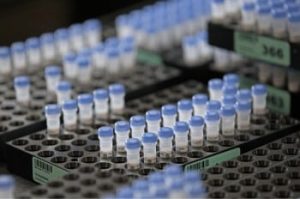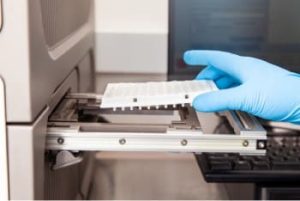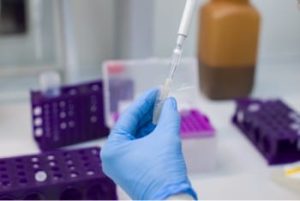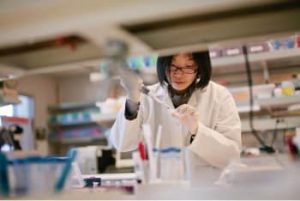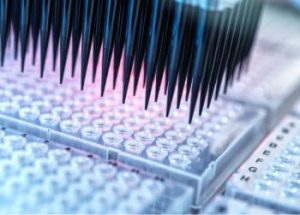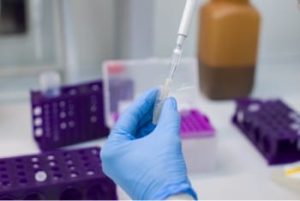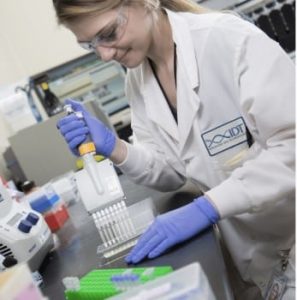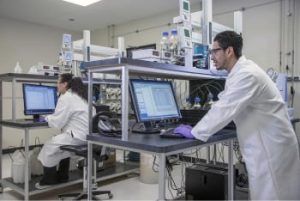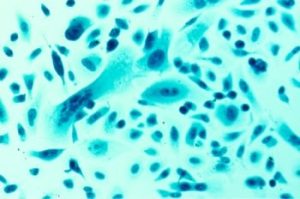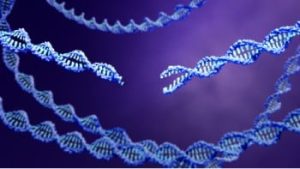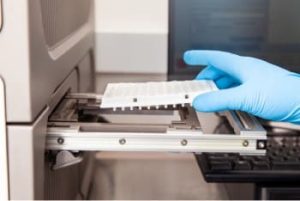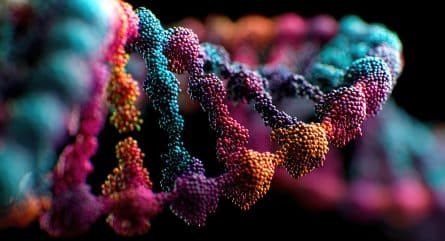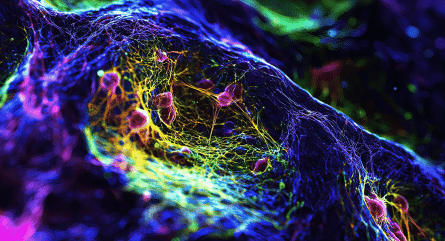IDT offers hundreds of useful modifications for oligonucleotides. Choosing the right one can be confusing. Begin by choosing a modification category based on your required function:
- Are you using the oligonucleotide as a substrate for DNA ligase? Phosphorylations
- Are you attaching the oligonucleotide to another molecule or surface? Attachment Chemistry/Linkers
- Are you using the oligonucleotide as a probe? Fluorophores and Dark Quenchers
- Are you looking for a 3’ blocking group? Is steric hindrance a concern? Spacers
- Do you want to change the hybridization characteristics? Modified Bases
- Is nuclease degradation a concern? Phosphorothioate Bonds
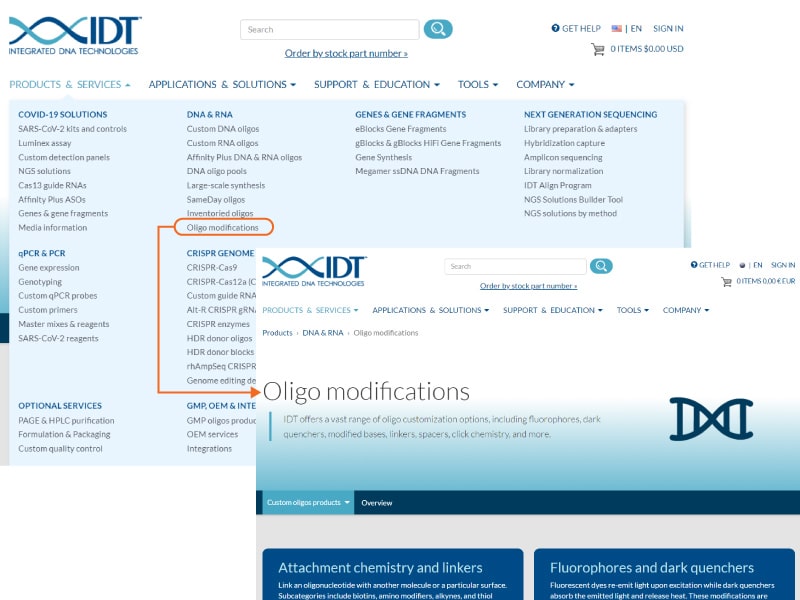
Phosphorylation
When generating synthetic oligonucleotides, including a terminal 3’ or 5’ phosphate requires alternate manufacturing steps to maintain or add the modification. Therefore, all IDT oligonucleotides are shipped without a terminal phosphate group unless requested. 5’ phosphorylation is needed if an oligonucleotide will be used as a substrate for DNA ligase. 3’ phosphorylation will inhibit degradation by some 3’-exonucleases and can be used to block extension by DNA polymerases.
Attachment chemistry/linkers
All of these modifications can be used to link an oligonucleotide with another molecule or a surface. Subcategories of this broad group of modifications are listed:
Biotins: Biotin is one of the most popular attachment chemistry options. For most applications, standard 5’ Biotin fulfills all needs. Standard biotin does not require additional purification and may be ordered at all scales. 5’ Dual Biotin inserts two adjacent biotin moieties in a sequence. This can slightly increase affinity to streptavidin. Biotin dT allows placement of a biotin internally without disrupting nucleotide spacing. Biotin-TEG helps reduce steric hindrance in applications that require the use of magnetic beads.
Amino-Modified Oligos: Primary amines are reactive with a number of useful molecules such as isothiocyanates, NHS esters, or activated carboxylates. The amino-modifier 5’ Amino Modifier C6 with a spacer arm of 7 atoms (6 carbon and 1 nitrogen) is the simplest choice. 5’ Amino Modifier C12 increases the distance between the functional amine and the DNA sequence. Amino Modifier dT inserts the functionality internally from an added dT base while the Uni‑Link™ Amino Modifier does so without an additional nucleotide.
Azide (NHS Ester): IDT Azide modification uses an NHS ester functional group to attach an azide moiety at the 5’, 3’, or any internal position in an oligonucleotide. This azide moiety may subsequently be used to attach alkyne modified groups using the click reaction.
Cholesterol-TEG: Cholesterol can be conjugated to oligonucleotides and can facilitate uptake into cells. It has been used as a transfection aid for antisense oligos and siRNAs.
Alkynes: Alkyne modifiers are used to react with azide-labeled functional groups to form stable bonds through the click reaction. 5’ Hexynyl is the simplest and most popular way to introduce a 5’ terminal alkyne group. 5-Octadinynyl dU is a modified base with an 8-carbon linker terminating in an alkyne group and is the preferred way to insert alkynes at internal positions within a sequence. This modification is also available for 3’ or 5’ attachment.
Thiol modifiers: A thiol group can be used to attach an oligonucleotide to a variety of fluorescent and nonfluorescent moieties or surfaces. Oligos containing thiol modifiers are shipped in their oxidized (disulfide) form and require chemical reduction by dithiothreitol (DTT) or Tris (2-carboxyethyl) phosphine (TCEP) prior to use. Dithiol can be inserted into an oligonucleotide at the 5’ position, the 3’ position or internally. Each insertion results in two SH groups available for coupling with ligands or surfaces (linkage to gold surfaces is one popular application). The dithiol phosphoramidite (DTPA) modification can be inserted in series so that 2, or even 3, groups can be positioned adjacent to each other to increase efficiency of ligand/surface interactions.
A protocol for the reduction of Thiol-modified oligonucleotides is available on the web site under SUPPORT & EDUCATION - SUPPORT - User guides and protocols. Access it here.
Fluorophores
Fluorophores can be sorted on the website by freedom of use, parent chemical structure, or excitation/emission wavelengths. For example, 5’ FAM is free of licensing restrictions, is derived from fluorescein, and has a peak emission wavelength at 520 nm. A wide spectrum of dyes are available with emission ranges from 520 to 800 nm.
Dark quenchers
These are molecules that are capable of absorbing light energy and releasing it as heat. Quenchers should be paired with a fluorophore that emits light in the optimum absorbance range of the quencher. Iowa Black™ RQ (absorbance range: 500–700 nm) is best suited for dyes that emit at longer wavelengths such as Cy5®, while Iowa Black™ FQ (absorbance range: 420–620 nm) is better for shorter wavelength dyes such as FAM, TET, HEX, VIC, or SUN.
Spacers
Spacers can be used to create distance between a functional moiety and the phosphodiester backbone of an oligonucleotide. Spacers are also often used when there is a concern about steric hindrance between the oligonucleotide and the desired functional group interaction or as a blocking group when oligonucleotide extension is not desired (for example, in a synthetic template). Many spacers are units of ethylene glycol, referred to as polyethylene glycol (PEG) spacers. Spacer 18 has six successive PEG units. Spacer C3 comprises 3 successive ethyl groups (not ethylene glycol). dSpacer is an abasic site that is useful for maintaining nucleotide spacing.
Modified bases
This is a very broad category in which different base modifications are introduced to serve a specific purpose. Some uses include cross-linking, duplex stabilization, and nuclease resistance. To select a modification for your application:
- Choose a category based on function.
- Start with the simplest version within the category.
IDT Customer Care is always available to guide you through the selection process, and you can contact us for inquiries about modified bases that may not be listed.
Phosphorothioate bonds
The phosphorothioate (PS) bond substitutes a sulfur atom for a non-bridging oxygen in the phosphate backbone of an oligo. This modification renders the internucleotide linkage resistant to nuclease degradation. Phosphorothioates can be introduced at either the 5’- or 3’-end of the oligonucleotide to inhibit exonuclease degradation. In antisense oligonucleotides, phosphorothioates are also introduced internally to limit nucleic acid digestion by endonucleases.
Click chemistry
Click chemistry is a novel class of attachment chemistry (azide-alkyne cycloaddition) that joins small chemical subunits in a modular fashion.
For research use only. Not for use in diagnostic procedures. Unless otherwise agreed to in writing, IDT does not intend these products to be used in clinical applications and does not warrant their fitness or suitability for any clinical diagnostic use. Purchaser is solely responsible for all decisions regarding the use of these products and any associated regulatory or legal obligations. RUO23-1711_001

